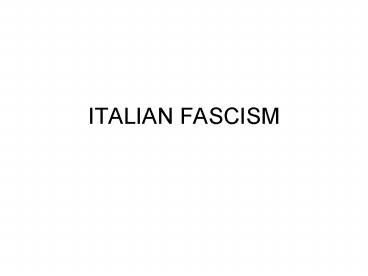ITALIAN FASCISM - PowerPoint PPT Presentation
1 / 19
Title:
ITALIAN FASCISM
Description:
Read through the fascist programmes for June, 1919 and November, 1921. ... Fascist seizure of provincial cities was more important in the King's decision. ... – PowerPoint PPT presentation
Number of Views:324
Avg rating:3.0/5.0
Title: ITALIAN FASCISM
1
ITALIAN FASCISM
2
AIMS
- To look at a brief history of Italian Fascism.
- To build up enough information on Italian Fascism
to allow a comparison with German Fascism in the
same period. - To investigate the nature of Mussolini and how
his brand of Fascism operated.
3
BENITO MUSSOLINI
4
EARLY LIFE
- Born July 1885 to a blacksmith and a school
mistress. - Poorly behaved at school expelled.
- Decided to become a teacher! He experienced the
humiliating struggle of the lower middle class. - Started political life as a Socialist.
- Forceful authoritative speaker.
5
INFLUENCES
- Marx (Socialism)
- Sorel (need for an elite role of violence)
- Nietzsche (role of a superman who can impose his
own laws) - Le Bon (how a brave leader could channel power of
the crowd) - Prezzolini (need to create a modern assertive
Italy)
6
TASK
- What kind of a person was Mussolini?
- Using the information on his early life and his
influences, do you think he would have been
closer to the left or to the right? - Read the quotations from Mussolini on your
handout. Say whether he was closer to the left or
to the right.
7
Let us have no more talk of battleships,
barracks, cannon, at a time when thousands of
villages have no schools, roads, electricity or
doctors, but still live tragically beyond the
pale of civilised life.
The national flag is for us a rag to plant in a
dunghill. Let us show that the fatherland does
not exist just as God does not exist.
Down with War! Down with arms and up with
humanity.
To offer the same kind of opposition to all wars
is stupidity bordering on the imbecile. Do you
want to be a spectator of this great drama or do
you want to be its fighters?
Who has iron has bread. Revolution is an idea
which has found bayonets.
From today we are all Italians, nothing but
Italians.
8
HOW FASCISM DEVELOPED
- 23rd March, 1919 foundation of Fascist party.
- 118 people present.
- Conceived as a movement appealing to all Italians
not a traditional political party. - It had little support until Mussolini
repositioned the party to the right and began to
exploit the fears of the upper and middle classes.
9
SUPPORTERS OF FASCISM
- Petty bourgeoisie insecure.
- Ex-soldiers let down by government.
- Farmers feared rural socialism.
- Industrialists feared Socialism.
- Students resented their lack of prospects.
- Youths wanting excitement.
- Workers Fascism kept some social radicalism, eg
fair wages, land to peasants.
10
What did Fascism offer?
Strong leadership
Unite all Italians
Law and order
Smash socialism
National greatness
Fascism had elements of both Left and Right
It was revolutionary, but could also sometimes
claim to be conservative. It was monarchist but
also republican, at different times. It was
catholic, but also anti-clerical it claimed
to be Socialist, but could also be strongly
capitalist whenever it suited the Duce Fascism
was not a doctrine, not ideas, not ideology, but
was really a means for winning power by a single
man. D. Mack Smith, 1990.
11
TASK
- Read through the fascist programmes for June,
1919 and November, 1921. - What similarities and differences are there?
- Which points would be most likely to gain
support? Why? - What were the similarities with Hitler and the
Nazis?
12
THE USE OF VIOLENCE
- Fascism depended on violence for its growth.
- Attacks against Socialist movement attacks on
buildings and members. - Elite condemned violence in politics but came to
see the Fascists as a party who could restore law
and order to Italy. - Many supported it because it was anti-Socialist.
- Some thought bringing the fascists into
government would tame them.
13
TASK
- Compare the use of violence by the Italian
Fascists with the use of violence by the Nazi
party in Germany. - How did both use it to gain power and support?
- Who were the targets of their violence?
- How did the elite and the authorities react?
14
MUSSOLINI GAINS POWER
- 1922 Liberal politicians divided about bringing
Mussolini into government. - August Socialists called general strike
failed. Fascists seen as saviours. - 24 October march on Rome announced.
- 28 October King agreed to impose martial law to
protect Rome. Changed his mind 7 hours later! - 30 October Mussolini proclaimed PM by King.
15
ANALYSIS
- March on Rome only happened after Mussolini was
declared PM. - Fascist seizure of provincial cities was more
important in the Kings decision. - Fascism was not hugely popular only won 7 of
vote in 1921 (compare with Hitler). - Mass popularity only came later.
16
FASCIST ITALY - OVERVIEW
- Read through the handouts.
- Pick four different colours and highlight the
following informationMussolinis dominance of
Italy.The nature and aims of Fascist
propaganda.Collaboration by the elite with
Fascism.The unattractive aspects of Fascism.
17
Special Tribunals applied summary justice
outside the normal court system.
Censorship
MSVN and squads. 50,000 armed militia. Opponents
intimidated and attacked.
OVRA (secret police) 20,000 actions per week
arrests and informers. Independent of regular
police.
How repressive was Fascist Italy?
Political Prisoners about 5,000. About 10,000
in internal exile.
Exiles
Controls internal migration had to be approved.
Deaths
18
ECONOMIC POLICY
19
FOREIGN POLICY












![⚡[PDF]✔ The Pope and Mussolini: The Secret History of Pius XI and the Rise of Fascism PowerPoint PPT Presentation](https://s3.amazonaws.com/images.powershow.com/10048394.th0.jpg?_=20240605099)


















